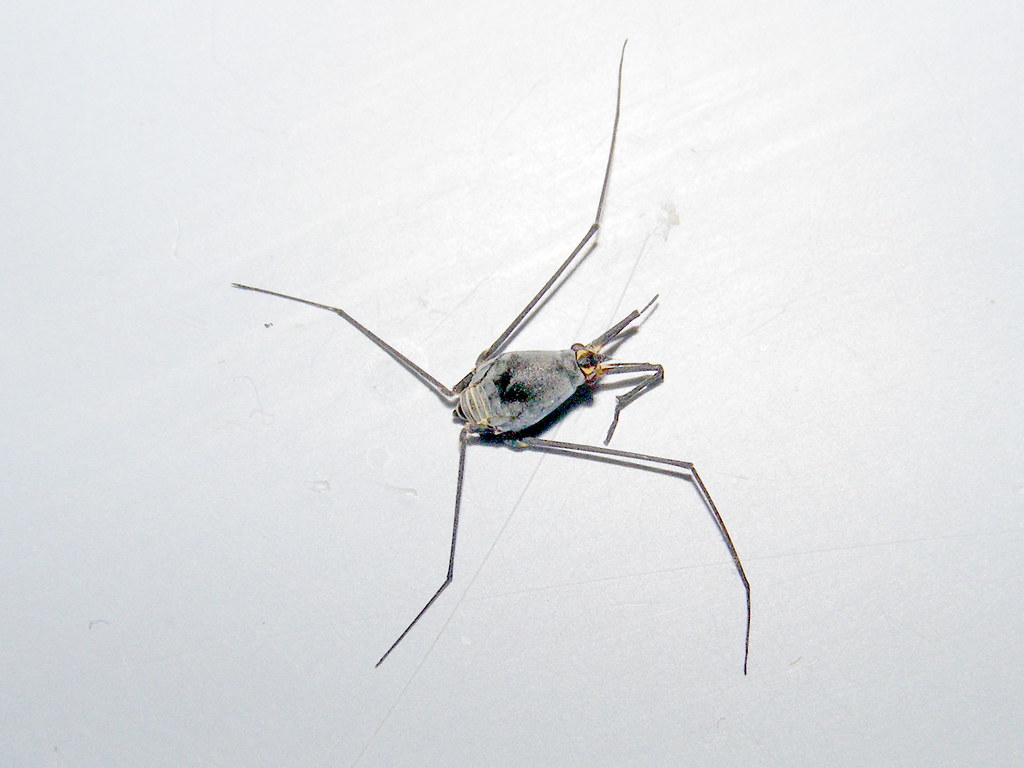#larviform female
Photo



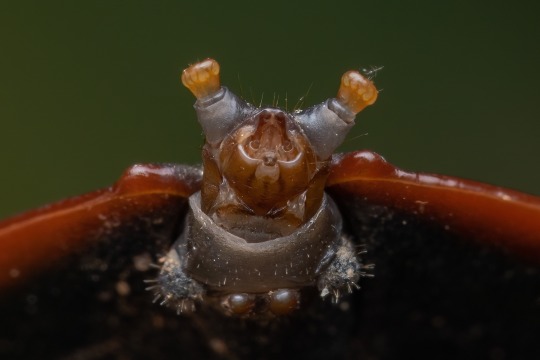
Trilobite beetle, Platerodrilus ruficollis?, Lycidae
Photographed in Malaysia by nadjabaum
#animals#curators on tumblr#insects#bugs#beetle#net winged beetle#trilobite beetle#larviform female#Platerodrilus ruficollis#one nice bug#while i'm on the topic of trilobite beetles#have this one#i love her
5K notes
·
View notes
Text

miss wormthing
#digital art#aseprite#pixel art#5/8/2023#been doing lots of pixel art lately it's just way easier on me#miss wormthing is a creature a friend of mine made for a ttrpg#she's based off a larviform female firefly :)#2023
7 notes
·
View notes
Text

BIG DISCOVERY IN ENTOMOLOGY!
An extraordinary case of elytra loss in Coleoptera (Elateroidea: Lycidae): discovery and placement of the first anelytrous adult male beetle
Vinicius S Ferreira, Felipe Francisco Barbosa, Milada Bocakova, Alexey Solodovnikov
Insects are one of the few groups of animals that developed the ability of active flight. Such mobility allowed the group to successfully explore and thrive in nearly all kinds of ecological niches.
At the same time, during the evolutionary history of insects, due to high costs of wing development, flight was lost independently in many groups. In beetles, the reduction or complete loss of hind wings has been reported in multiple lineages, especially in several extreme paedomorphic and larviform females, mainly in Elateroidea, in which not only the hind wings but also the elytra are lost.
However, the complete absence of elytra in adult males was hitherto unknown, despite nearly half a million described species in Coleoptera.
In this study, we report the discovery of Xenomorphon baranowskii gen. et sp. nov., the first completely anelytrous and wingless adult male beetle, belonging to the family Lycidae (Coleoptera: Elateroidea). Xenomorphon baranowskii is illustrated, described, and provisionally placed in Calopterini, based on our morphology-based phylogenetic analyses.
We discuss the possible scenarios that could lead to such a rare event, when a beetle loses its elytra, and its evolutionary consequences.
Read the paper here:
extraordinary case of elytra loss in Coleoptera (Elateroidea: Lycidae): discovery and placement of the first anelytrous adult male beetle | Zoological Journal of the Linnean Society | Oxford Academic (oup.com)
2K notes
·
View notes
Note
bogleech do you know anything about trilobite beetles? im trying to learn more about them but all i can find is videos and articles about how rare they are. i want to learn more about them, like why they have a suction cup on their tail, or why they are orange, or why their head is so small
Trilobite beetles are an example of extreme sexual dimorphism and a "larviform" adult stage; the adult males are tiny flying beetles, but the adult females resemble giant versions of the larvae!

The colors are actually for the same purpose as the lights on an airport runway; the male can spot them from above, and follows the orange trail to where he needs to be, as seen here!
The group containing these beetles is closely related to fireflies (or "lightning bugs"), and in fact fireflies have the same type of "trilobite larvae!" This is a baby firefly:

But in fireflies, the tiny head is specifically an adaptation for preying on snails, the ONLY thing most firefly species ever eat! The head can even extend into the snail's shell on this turtle-like neck you see here.
Trilobite beetles don't have the extending neck, nor do they have sharp predatory mandibles, so they do not eat snails. Unfortunately that's all we know; trilobite beetles never live long in captivity no matter what materials they're offered, so their diet is a mystery, and that's not unusual for rainforest insects. There's many we know almost nothing about!
I should also mention, there are also some firefly species with the larviform female! They don't keep looking EXACTLY like the larvae do, but close:

So it's actually possible to have your own version of "trilobite beetles" hiding around right in North America! I've actually seen one of these species (just one) right outside our Apartment here in Oregon:

The West Coast of the USA has no fireflies who light up as adults, but it has fireflies who light up as larvae AND have these trilobite ladies!
419 notes
·
View notes
Note
hello! would you be able to help me identify this... thing? my mom is convinced this is the egg sac of some sort of bug but neither of us have any idea what kind it may be. is this even a bug thing? if so, what kind? thanks ♡

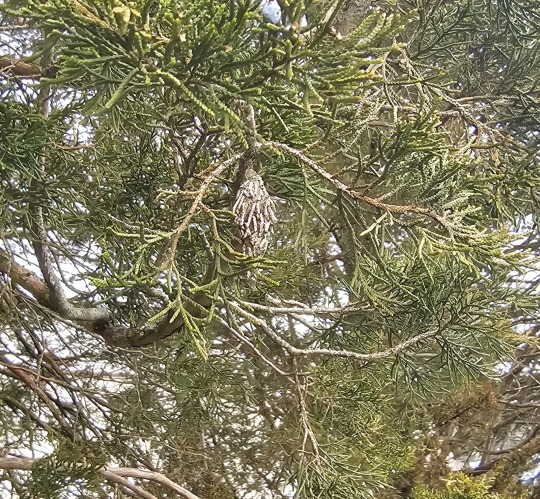
posting this one on my main since I need a reminder to get through all of the bug submissions on @crawlingkind + also I have some specimens to share!
that is a structure made by Thyridopteryx ephemeraeformis, a species of bagworm moth. I’m not sure if it’s occupied since empty bags can stick around for years but it could contain either a larva, a pupa, or an adult female. the caterpillars can eat a wide range of plants, and incorporate items from their environment into a sturdy, weatherproof silken bag, which they drag behind them wherever they go. once they are ready, they tie the bag to a perch and pupate. only the male emerges as a recognizeable moth, and flutters around in search of females.

a male and a small case, probably from another male.
the adult female is often described as remaining larviform, but she is even more wormlike than the caterpillars: she is a featureless tube of fat and egg-laying machinery, lacking functional eyes or antennae, and with no legs or wings to speak of. she will die in the bag, surrounded by her eggs, who will hatch the following season.


317 notes
·
View notes
Text
Glowworms
(because i keep getting asked about them)

[ID: An adult female glowworm of the species Lampyris noctiluca. It has a bright green glow and clings to a plant.]
Before I even get started, let me lay down some education on the entire Lampyridae family so that we're all on the same page about the specific species that I'm going to talk about for the UK. I've done more research on this topic than the last time I brought it up, and I come bearing knowledge
Lampyridae is a family of beetles, descended from a bio-luminescent ancestor. There are more than 2000 species of Lampyridae, and they can be VERY different. This family is called "fireflies," "glowworms," and "lightningbugs" but ALL of those common names are AWFUL for referring to the full family becaaaaaauuuusee...
Not all lampyridae can fly
Not all lampyridae can glow as adults
Not all lampyridae light up passively; some use it as a lure or a warning
Not all lampyridae light up during flight
In the US, our most iconic species light up during flight, and our most common species have males and females capable of flight. So when I'm talking about "glowworms," remember that those traits are not shared by ALL species of Lampyridae, and especially not this one.
The UK has one species of glowing Lampyridae, Lampyris noctiluca, the Common Glowworm. There's one other, non-glowing species but it's extremely rare and only in the south, and an occasional visitor from mainland Europe.
GLOWWORMS
Only the female lights up, and her final stage is not capable of flight. This is called a "larviform female," because she looks like the wormy adolescent stage that all Lampyridae go through.
The female will climb up to the highest blade of grass she can find and wiggle her butt around until a male, who CAN fly and does NOT glow, finds her. Then she lays eggs and dies.
So because the adults do not eat and quickly die after reproduction, most of a glowworm's life is spent as a larva.
The larval glowworm is a SPECIALIZED predator of gastropods. They hunt snails and slugs for ONE or TWO YEARS (depending on how much food there was in the first year), hibernating over the winter, then waking up and doing it again. All movement in the species is done by the larvae; they have a REALLY hard time establishing new colonies because of this.
This is NOT a pioneer species. You need to have undisturbed grass, moor, or heath, no pesticides, not overgrazed, not brightly lit, for generations of these insects AND their prey. It's REALLY easy to decimate the glowworm population in an area via carelessness.
(let alone the horror story in the Glowworm Survey page where a tiny colony was intentionally destroyed, which is why they have a policy about keeping quiet on reports of certain colonies except to researchers ;_;)
so LOOK AT ME
HOLDING YOU BY THE SHOULDERS
You need to protect glowworm populations when you can. If you ever briefly hear posts in passing shouting about sterile lawns, light pollution, and pesticides, THIS IS WHY. If you live on the island and feel like there's a shit ton of slugs in your garden for some reason? Might be because these factors killed off their specialized predators, leaving you with an unfilled ecological niche.
Environment
Hypothetically, glowworms should be distributed all across Great Britain, except the Scottish highlands, though they have the strongest concentration in southern England.
Functionally, their population is incredibly fragmented. They need tall grass or heather, low light pollution, undisturbed (no pesticide) land, and lots of gastropods to eat. While they can work with forest verges and railways, places for them to thrive are getting rarer and rarer in the UK.
So to restate their very specific environmental needs;
Undisturbed land
Glowworms and construction don't mix. Pollution, pesticides, and destruction can destroy the little patches of land glowworms have left. They need up to two years to go from eggs to adults, and a safe place for that to happen in.
A population of gastropods
Baby glowworms eat slugs and snails. Because of that, they can't live where it's too dry.
Tall grasses, shrubs, or heathers, but not TOO tall
A tree won't do! Glowworms do not live in trees! The females need a tall stalk to climb to the top of, so that they can signal to flying males. At the same time, they can't hunt or find each other in a savanna or a wheat field. Well-managed heathlands are excellent habitat for glowworms.
Low light pollution
If it's too bright, males can't find females. Highways with heavy traffic, urban areas, and anything else that gives off constant light will affect the glowworm population.
They glow in June to May, in summer, at night. You won't find glowworms in winter, as all the larvae are hibernating at that time.
BB FAQ
When I determine if something will show up in the Better Bones AU and my Clan Culture expansions, I use iNaturalist to suss out if people are seeing it in the modeled region. Lads, there is a bald spot in my modeled regions. It's almost comical. The closest is in DERBYSHIRE, RIGHT out of reach.
So I'm still unsure about adding them. For now, they are not in BB. I GOT A REPORT FROM A FAN I will be adding them to BB.
"How do Clan cats feel about them?"
They're unfathomnably holy, especially because they spend their larval stage eating snails which can be used in divination rituals. WindClan in particular considers themselves blessed for living around them.
"Can you use glowworms to light up the night?"
Yes but that's really bad for their populations; leave them be! Clan cats wouldn't use something so holy in such a trivial way.
"Can you eat glowworms?"
No they taste really bad. The chemical that makes them light up is REALLY bitter, and it's present in both the larvae and adults. Plus Clan cats wouldn't eat something so holy.
97 notes
·
View notes
Text
youtube
The reveal of primal malzeno as sunbreak’s final boss ended up postponing the malzeno vid, so UHC will be waiting till the last title update to continue working on it.
Instead we got a seltas vid, and while I didn’t have a part in this one since I’m mostly the phylogenetics and anatomy guy, @krmoaten-blog made art for the video so go give her a follow. And also I prompted an interesting conversation between my fellow poopenshitters about the pincers on seltas queen.
Seltas are obviously meant to be rhinoceros beetles since Capcom modeled the male’s anatomy as closely to Dynastinae as they could with 3DS graphics (and rhinoceros beetles are kinda big in Japan so it was only a matter of time till we got a monster of one), and they even gave him an aedeagus! The insect equivalent of a penis. The mantid-like claws aren’t really indicative of evolutionary relation since raptorial appendages are a pretty easy thing to evolve in arthropods.
The queens are pretty odd though and are almost larviform in anatomy. And while she also matches up with beetle anatomy pretty well, her pincers threw me for a loop since beetles don’t have abdomen pincers. At first I thought they were derived from parts of the vagina but after bugging @revretch about it it seems that there isn’t a part of the vagina that can be modified into pincers. So the theory I came up with and shared is that it’s a modified forked aedeagus.
My theory is that seltas queens don’t face too much pressure to retain normal reproductive systems since they’re making 100% of the decisions when it comes to reproduction, and eventually became intersex like moles but with weird aedeaguses. Eventually they evolved to actually put those aedeaguses to use by giving them joints to hold onto mates during reproduction and it just kinda went from there.
So tldr, there are no female seltas. Only males and hulking cannibalistic “queens”.
As far as my thoughts on them go I think they’re amazing and seltas is definitely the best beginner monster. I also love their designs and seltas queen is a giant arthropod done right, with her massive columnar legs that don’t end in points. Whenever I design giant arthropods I actually reference her.
Follow my poopenshitter friends who have tumblrs! @dappercritter, @lizard-legendarium, Krmoaten, @astralarchilocus, @glavenychus
#UHC#unnatural history channel#monhun#monsterhunter#monster hunter#monster hunter biology#speculative biology#speculative evolution#speculative zoology#speculative anatomy#krmoaten-blog#revretch#seltas#seltas queen#i honestly feel bad for the males#Youtube
53 notes
·
View notes
Text
Something to note about the Fireflies in Bug World No Mercy is that they're not the types of fireflies that you'd expect.
The Fireflies that will be seen in the story are actually Douglas Fir Glowworms
The males look like a regular, winged adult, but can't glow
That actually goes to the females. But instead of looking like regular adults, they take on a Larviform appearance. Meaning that they keep their general larvae form even into adulthood
I had a little bit of difficulty trying to find a good Firefly species that occurs in California but I'm happy with what I have now.
9 notes
·
View notes
Text
Round 1 Match 52


Glowworm: "They’re weird glowing beetles where the females resemble grubs and are difficult to distinguish from the larvae (that is, they’re larviform), while the males are much smaller winged beetles with giant feathery antennae. The larvae and females (but not males) glow in a similar manner to fireflies from a pair of green or yellow glowing spots on each body segment, and Phrixothrix sp. also have a head that glows bright red. They don’t seem to use their glowing abilities primarily for mating (males use their sensitive antennae to track down females by scent, and larvae glow the same as adults) and the reason they glow is unknown but presumed to be aposematism, weird part is they glow constantly and don’t seem able to turn the lights off. They’re specialist predators of large millipedes, the issue is that millipedes have toxic secretions that ooze from glands when threatened. Many predators that feed on toxic prey simply evolve immunity, but glowworms aren’t immune- instead they bite millipedes and inject them with a paralyzing venom that incapacitates millipedes so quickly they don’t have a chance to release much of their secretions. They then eat the millipedes by very carefully hollowing them out to eat the meat that isn’t contaminated by the toxins."
Sea Sheep: "one of v few non-single-celled moving critters that photosynthesizes"
76 notes
·
View notes
Note
Opinion on that really big fluffy past moth pokemon? (I forgot it’s name but past Volcarona)

We heard from leaks that there was going to be two paradox Volcarona 'mons, which was exciting for me because Volcarona's one of my favorite moths in the series. While Iron Moth was underwhelming, I'm pretty pleased with Slither Wing here as a whole.
First, I just think the idea of a larvae-like form for Volcarona is neat. Some bugs do keep larvae forms as adults, including the female trilobite beetle (known as a larviform female):
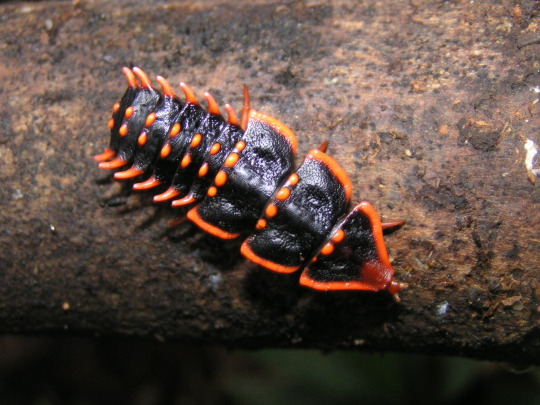
While there's nothing inherently prehistoric about this except for appearance, it does work well for a past paradox. It kind of invokes Larvesta but really looks nothing like it apart from still being a caterpillar, giving Slither Wing its own identity.
(Side note: Am I the only one who thinks that "slither" is a particularly weird way to describe a caterpillar's movement? Caterpillars more crawl, slithering is more how you'd describe a snake. But I digress.)
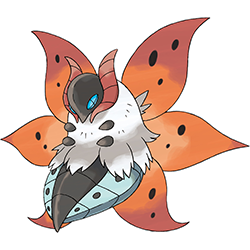
Visually, I like how it plays off of Volcarona's design. It would've been easy to keep everything the same as Volcarona just as a caterpillar this time, but instead they had some fun changing up the elements in the design while keeping them recognizable. For example: the body fur is fluffier, the eyes are now yellow and have "eyeliner", the antennae are forked, the wings are now tipped with yellow and have green diamond accents instead of black ovals, etc.
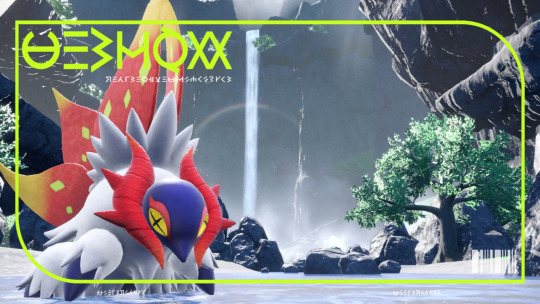
In all honestly, I think it actually looks better than Volcarona in some respects—and like I said earlier, I like Volcarona a lot. The yellows and greens really make the wings pop and give it some brilliant color, the yellow eyes feel like a more natural color choice than the blue of the original, and the palette is, for the most part, more coherent.
The only things in this design that I think were missteps were that, first off, the ovals on the wings matched the roundness of the body more and overall felt more natural than Slither Wing's diamonds. And secondly, it's hard to see in the above images, but it has a tail:

This is possibly supposed to invoke Larvesta's brown segmented abdomen, and while I'm not sure how much it was needed, I'm not opposed to the idea; it's an interesting feature to put on a bug, and makes it look all the more wild and ancient.
The problem is the colors; making it that awful teal is a terrible choice, as it draws way too much attention to it and it muddies an already busy palette by introducing yet another color. This also makes it feel disconnected from the rest of the body. It would have been considerably better if it was black like its head and legs; it can keep the light green spikes to match the wings, or it can swap them for a yellow or red. Regardless, that's the only real misstep in an otherwise solid design.
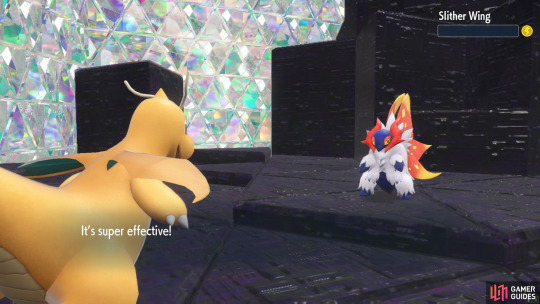
Also, not related to the design, but bug/fighting is kind of an odd choice for this one. It can rear up on its hind legs, but I can't really see it doing martial arts moves, you know? I've heard some people say bug/dragon, and while I wasn't sure about that at first, it does fit the more I think about it—it has a reptilian tail, walks on all fours, has wings on its back, and the antennae look like horns. This isn't a huge deal, but I figured it was worth mentioning.
So, overall, this is probably one of my personal favorite paradox Pokemon. I think the concept is very neat and looks appropriately prehistoric, yet it has its own unique design that honestly looks better than Volcarona's in many ways. The only misstep is making the tail a very garish color that isn't used anywhere else in the design—everything else is pretty great.
102 notes
·
View notes
Text
Larve, nymphe ou adulte ? Le cas de la femelle de Platerodrilus (Coleoptera : Lycidae)
Larva, Pupa or Adult? The Female of Platerodrilus Case (Coleoptera: Lycidae)
by Kirill Vladimirovich Makarov et al.
Published: 2 December 2022
Diversity 2022, 14(12), 1063; https://doi.org/10.3390/d14121063
(This article belongs to the Special Issue Mega-Diversity of Beetle Species—Perspective on Taxonomy, Systematics, Morphological Evolution and Zoogeographical Patterns of Coleoptera (Arthropoda, Insecta))
-------
NDÉ
Traduction via DeepL
L'anatomie et les organes génitaux d'une femelle larviforme ont été étudiés pour la première fois dans la famille des Lycidae. La structure de l'exosquelette et de l'endosquelette d'une femelle Platerodrilus n'est pas très différente de celle de sa larve, les appendices génitaux externes étant à peine différenciés.
L'appareil reproducteur comprend une spermathèque non appariée, des oviductes et des ovaires appariés. La structure du tégument est également particulière, avec deux couches de cuticule dont la structure diffère. D'autre part, le labrum et les mandibules ne ressemblaient pas du tout à ceux des larves : le labrum n'était pas divisé et les mandibules étaient entièrement métamorphosées.
Cette étrange combinaison de caractères morphologiques peut être interprétée de deux manières. Tout d'abord, on peut émettre l'hypothèse qu'il s'agit d'une nymphe. Cependant, ses appendices génitaux sont plus simples que ceux des nymphes "normales" de Lycidae ; les ailes ou leurs rudiments sont complètement absents ; il y a très peu de caractéristiques de la morphologie imaginale dans la structure externe.
Nous proposons donc une autre hypothèse : il s'agit du stade précédant la nymphe, que Hinton (1946) désigne sous le nom de "prepupa".
Mots-clés :
Coleoptera ; Lycidae ; Platerodrilini ; morphologie ; anatomie larvaire et imaginale ; région orientale
Bernadette Cassel's insight:
En relation
Les femelles coléoptères du genre Platerodrilus restent sous forme larvaire jusqu'à l'âge adulte... - De twitter.com - Aujourd'hui, 18:13
0 notes
Photo
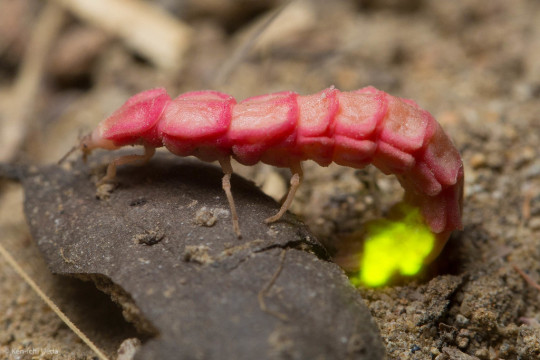
PINK GLOWWORM
Microphotus angustus
©Ken-ichi Ueda
Females of this species never morph into winged firefly beetles, but morph instead into ‘larviform’ reproductive adults; not really worms at all. However, the males of this species do morph into non-glowing winged fireflies ready to embark on the hunt of their night-lives: the bright glows of their instinct’s desire.
The female Pink Glowworm is not a blinking firefly like those back east; but rather shines forth with a bright steady neon-green glow waiting for her suitor to see her glow and come down for a visit. The adult female has only about ten days before her light producing abilities cease. If a male does not find her by then her lineage comes to an end.
But happily, most Pink Glowworms do meet up; the eggs are laid in the soil under moist leaf litter, and the larvae hatch and begin their secretive lives by munching on small soft bodied invertebrates such as earthworms, snails, and other insect larva.
Look for the light of Pink Glowworms within our foothills during spring and early summer nights, typically within oak woodlands. (source)
#microphotus angustus#©ken-ichi ueda#females glow#males do not#california#insect#coleoptera#beetle family#larviform#mountain valley living#animals#firefly#pink glowworm#arthropods
81 notes
·
View notes
Text

Chub! I like to think that she’s a beetle, not a maggot. Technically, she’d have to be a larger-than-a-person beetle that either remains as a grub their whole lives (neotenic, like an axolotl) or a type of beetle with larviform females- an actual phenomenon found in things like trilobite beetles where the females specifically remain in a larval form their whole lives.
54 notes
·
View notes
Note
are there insects that live in the sea or at least on its surface? as in not insect-equivalent arthropods like crustaceans and stuff but as in legit insects of the six legged variety
if you count mangroves and brackish environments, as well as seashores, there’s quite a few insects that live there. but there are very few that live on or in the ocean!
the most successful are the sea skaters (Halobates) and even only a few of these live on the open ocean, most being coastal. they are hemipterans in the same family as waterstriders, but smaller and differently shaped than their freshwater relatives. they hunt plankton and scavenge, laying eggs on floating debris.
another really bizarre one is a genus of flightless fly, Pontomyia. males have elongated appendages and swim by rowing their shrunken wings, while females are legless and larviform. they’re still fairly tied to shore I think but their larvae have been found living on sea turtle shells, hinting at their ability to spread across oceans this way!
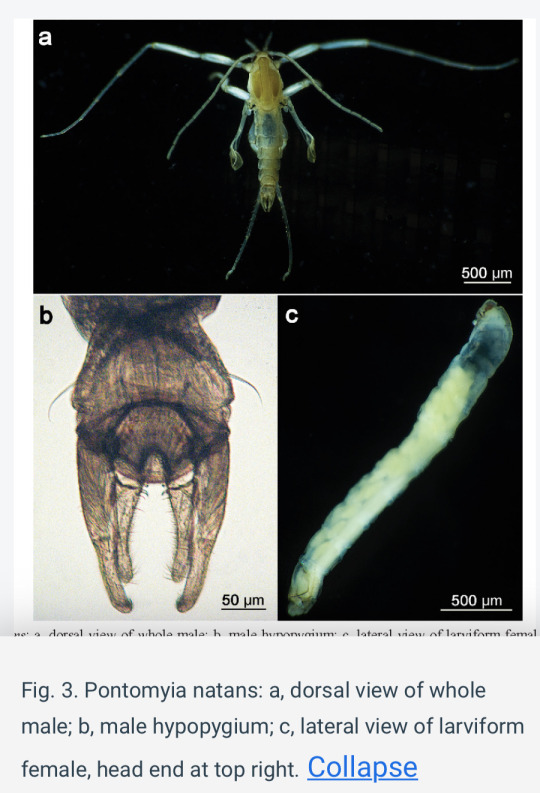
https://www.semanticscholar.org/paper/Discovery-of-the-flightless-marine-midge-Pontomyia-Cheng-Huang/792a66efd06891fab4055a3f3a94897723cf41f5
142 notes
·
View notes
Text
#1633 - Fam. Lampyridae - Firefly


Photo by Sara Stephens-Huddleston, at Northerm Rivers, NSW.
Either a larval firefly, or the larviform adult female - I’m not sure. I depends entirely on what species it is.
20 notes
·
View notes
Text

A railroad worm is a larva or larviform female adult of a beetle of the genus Phrixothrix in the family Phengodidae, characterized by the possession of two different colors of bioluminescence.[1] It has the appearance of a caterpillar. The eleven pairs of luminescent organs on their second thoracic segment through their ninth abdominal segment can glow yellowish-green, while the pair on their head can glow red;[1] this is due to different luciferases in their bodies, as the reaction substrate, called luciferin, is the same.[2]
(Source)
5 notes
·
View notes
